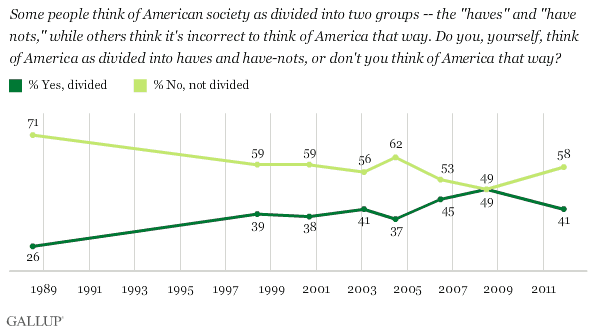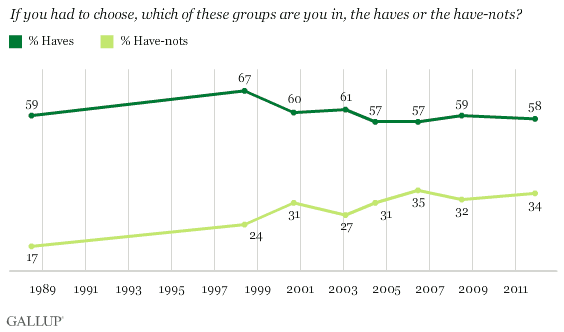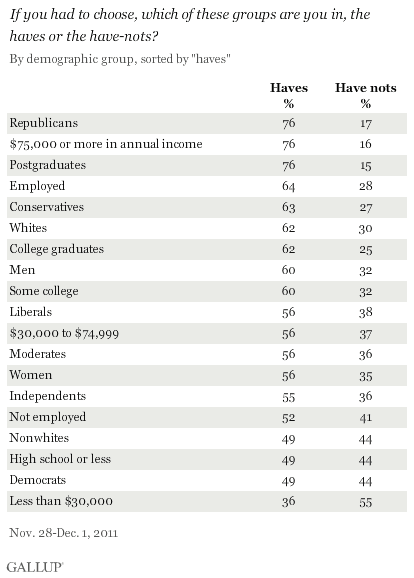WASHINGTON, D.C. -- Americans are now less likely to see U.S. society as divided into the "haves" and "have nots" than they were in 2008, returning to their views prior to that point. A clear majority, 58%, say they do not think of America in this way, after Americans were divided 49% to 49% in the summer of 2008.

The shift, documented by a Gallup poll conducted Nov. 28-Dec. 1, is noteworthy in that it came after 3 ½ years of economic turmoil in which more Americans have become unemployed and more have become negative about their personal finances. The current poll was also conducted as the Occupy Wall Street movement continues to focus on the disparities between the wealthiest 1% of Americans and everyone else.
If they had to choose, 58% of Americans would say they are in the "haves," rather than the "have nots" group. This breakdown has held remarkably steady over the past two decades of economic boom and bust, with a record-high 67% of Americans putting themselves in the "haves" category during the strong economic times of the late 1990s.

Not surprisingly, Republicans and Democrats are on opposite ends of the spectrum in both cases, with Democrats more likely than Republicans to say society is divided into haves and have nots, and more likely to see themselves in the "have nots" group. However, it is independents and moderates who since 2008 have grown significantly less likely to see society this way.

Postgraduates and those making $75,000 or more per year join Republicans as those most likely to label themselves as "haves." Americans making less than $30,000 per year, nonwhites, those with a high school education or less, and those not employed join Democrats as the groups most likely to label themselves as "have nots."

Implications
Americans' views of their own position as "haves" or "have nots" have been remarkably stable, even as the nation's economic problems have intensified. Still, the finding that fewer Americans now than in 2008 consider U.S. society as divided into "haves" and "have nots" suggests a decreasing -- rather than increasing -- level of worry about unfair income distribution in the U.S. at this time.
As populists and politicians have made inequality more of a political issue, moderates and independents in particular are turning away from the idea of a society divided in two. Thus, Americans as a whole are no more likely to see the country as divided into haves and have nots than at any time in the past two decades.
Survey Methods
Results for this Gallup poll are based on telephone interviews conducted Nov. 28-Dec. 1, 2011, with a random sample of 1,012 adults, aged 18 and older, living in all 50 U.S. states and the District of Columbia.
For results based on the total sample of national adults, one can say with 95% confidence that the maximum margin of sampling error is ±4 percentage points.
Interviews are conducted with respondents on landline telephones and cellular phones, with interviews conducted in Spanish for respondents who are primarily Spanish-speaking. Each sample includes a minimum quota of 400 cell phone respondents and 600 landline respondents per 1,000 national adults, with additional minimum quotas among landline respondents by region. Landline telephone numbers are chosen at random among listed telephone numbers. Cell phone numbers are selected using random-digit-dial methods. Landline respondents are chosen at random within each household on the basis of which member had the most recent birthday.
Samples are weighted by gender, age, race, Hispanic ethnicity, education, region, adults in the household, and phone status (cell phone only/landline only/both, cell phone mostly, and having an unlisted landline number). Demographic weighting targets are based on the March 2010 Current Population Survey figures for the aged 18 and older non-institutionalized population living in U.S. telephone households. All reported margins of sampling error include the computed design effects for weighting and sample design.
In addition to sampling error, question wording and practical difficulties in conducting surveys can introduce error or bias into the findings of public opinion polls.
View methodology, full question results, and trend data.
For more details on Gallup's polling methodology, visit www.gallup.com.
